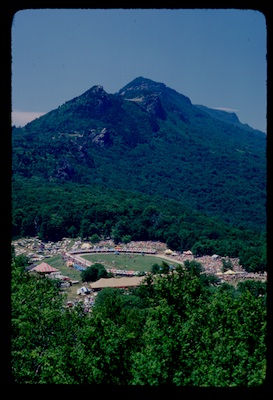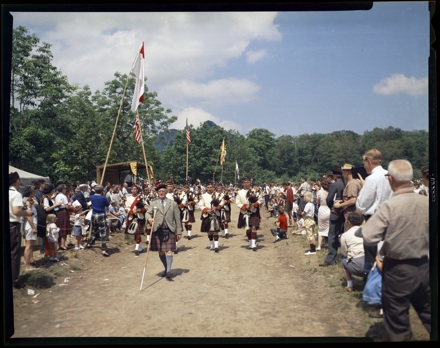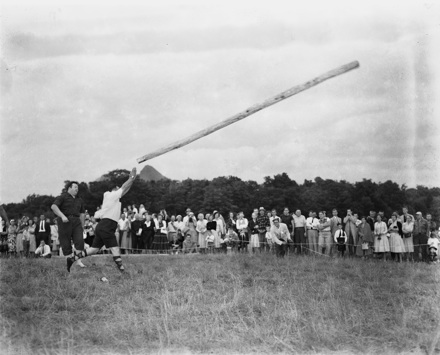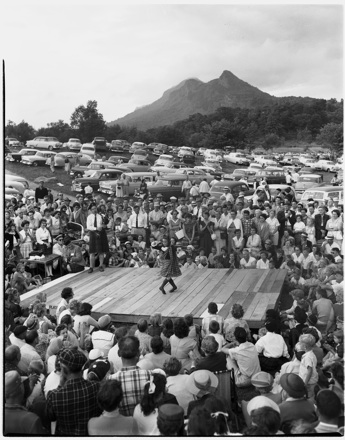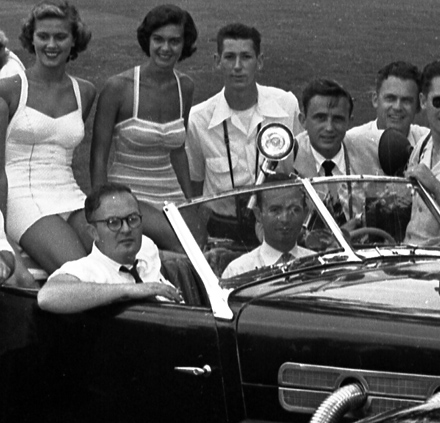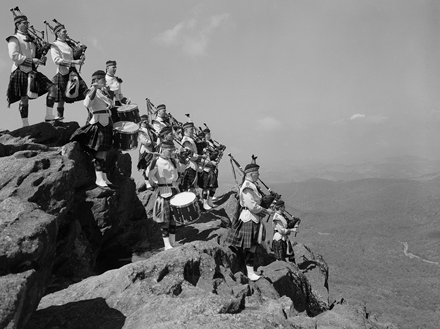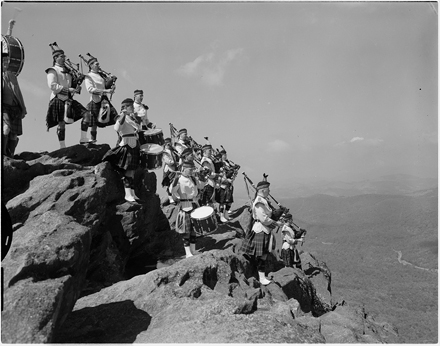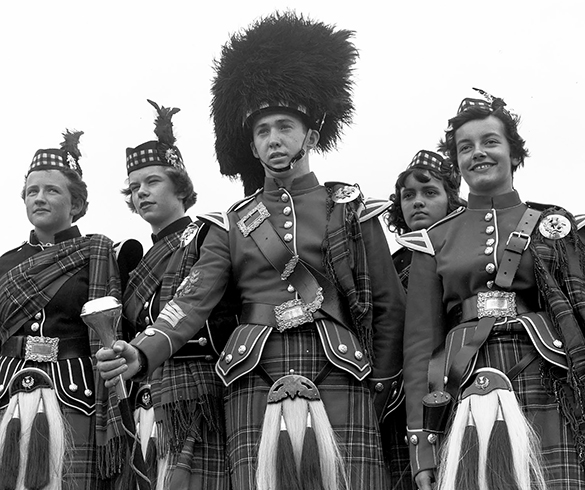
The 61st annual “Grandfather Mountain Highland Games and Gathering of Scottish Clans” takes place in Linville’s MacRae Meadows from July 7th through July 10th, 2016. This spectacular happening has become one of the most popular and colorful events of its type in all of North America. As we celebrate once again this mountain event, Morton Collection volunteer Jack Hilliard looks at the first “gathering and games” back in 1956.
. . . there is the annual Grandfather Mountain Highland Games and Gathering of the Scottish Clans, which must be seen to be believed. Powerful men wearing skirts compete in tossing telephone poles about. Who can explain such a thing? It is Scottish.
—CBS News legend and Hugh Morton’s friend, Charles Kuralt, June 7, 1996
Sunday, August 19, 1956 was a special day at MacRae Meadows in the shadows of Grandfather Mountain. On that day, the first Highland Games ever held in the South were staged to the delight of about 10,000 spectators according to The Asheville Citizen issue of August 20th.
Many months of planning and preparation had gone into the event and according to the 1976 Souvenir Programme and Review booklet, the idea for a gathering began to take shape when Mrs. J. W. Morton (Agnes MacRae) read an article about Scottish gatherings in other areas and began talking about the idea for a gathering at Grandfather Mountain. One of the people she contacted, in 1955, was Donald F. McDonald of Charlotte.
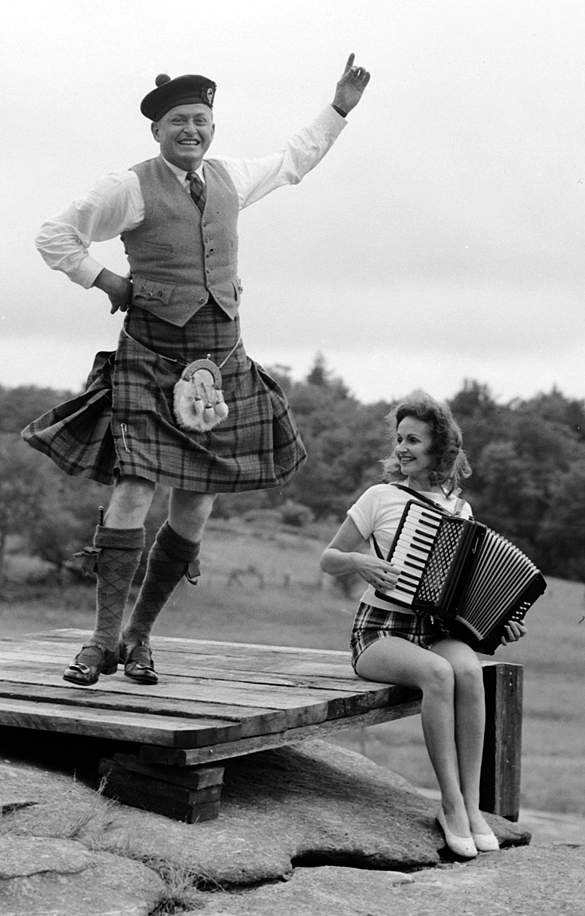
McDonald had attended Scotland’s famous Braemar Gathering in 1954 and suggested that highland games would attract more visitors than just a reunion of individual clans. Morton and McDonald planned for a one-day event, based on the Braemar Gathering with performances of Scottish songs and dances along with athletic events including foot races, wresting, the high jump, and the shot put. Even today, the Grandfather Mountain Highland Games and Gathering of Scottish Clans is often called “America’s Braemar.”
The festivities started that morning in 1956 at 11 o’clock with a church service conducted by Mr. MacDonald. Honored guests were introduced next. Two bands were present: the Washington, D. C., St. Andrew’s Society Pipe Band under the direction of Pipe Major Gene Castleberry, and “The Fighting Scots” Brass from Scotland County High School in Laurinburg, N. C.
The highland dance competition was held on a large platform as was the piping competition. Major Castleberry won the professional bag piping competition, and William Firestone of Cumberland, Virginia took home the novice piping honors.
The field activities took place in both the East and the West Meadows. A racing path was marked off in the same area where an oval track would be built in 1958. The track and field competition included a 60-yard and a 100-yard dash, a 2-mile cross-country race, pole vaulting, and a tug o’ war.
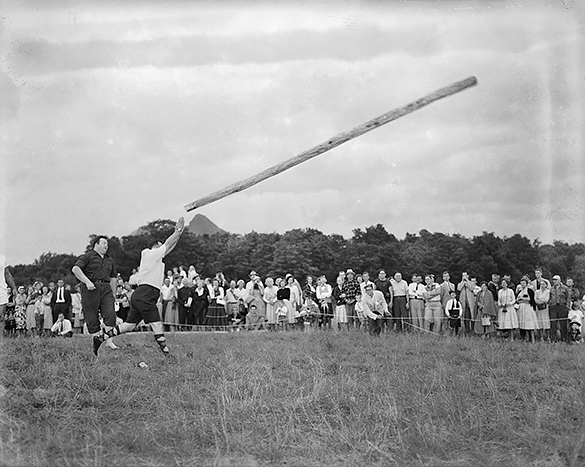
One of the highlights of the day was the caber toss (sometimes called “turning the caber,” which requires the athlete to flip a telephone pole-sized tree trunk end-over-end for distance and accuracy). Ronald Patterson, a student from Appalachian State Teachers College (today’s Appalachian State University), won the competition. He tossed the 200-hundred pound caber 36 feet, 10 inches. Patterson also won the shot put contest. Other track-and-field winners included Leslie Taylor of Charlotte, high-jump; Clyde Autin of Boone, cross-country; Paul Arrington of Charlotte, broad-jump; and Vance Houston of Charlotte, 60-yard dash.
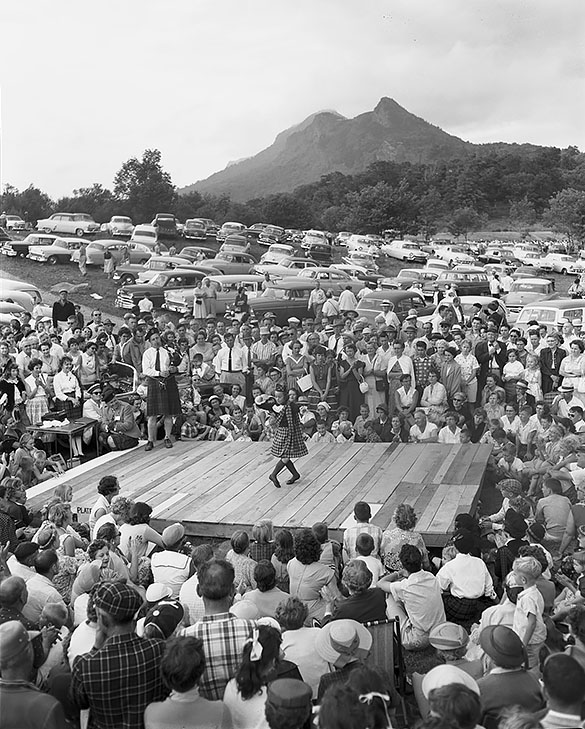
The Asheville newspaper described the Highland dance competition winner as “an Asheville lassie, little red-haired Margaret Fletcher.” She also received the trophy as the best all around dancer. (An interesting side note here: little Margaret Fletcher’s older sister, Maria, was crowned Miss North Carolina in the summer of 1961 and went on to become North Carolina’s only Miss America that September).
Lads, Lassies Twirl Tartans, Roll R’s —The Greensboro Daily News, August 20, 1956
The continuing success of the highland games at Grandfather is due in large measure to the beautiful setting. Agnes MacRae Morton’s father, Hugh MacRae, developed the town of Linville at the foot of Grandfather Mountain in Avery County. The rugged terrain is similar to the landscape of some areas of Scotland. Morton volunteered the use of MacRae Meadows and the Morton family has continued to support the gathering and games for over sixty years with Agnes Morton’s son, Hugh MacRae Morton, taking a significant role in the promotion of the events with his magnificent photographic and public relations skills prior to his death a little more than one month before the 2006 games. For the 1956 event, Morton was able to land a magazine cover image for The State showing Donald MacDonald, Chieftain of the ’56 games, beside Angus MacKinnon MacBryde of the Isle of Mull, Scotland. The August 11th issue promoted the upcoming games on the 19th.
The gathering and games, now held annually the second full weekend in July, regularly attract more than 30,000 and have made not just the event, but the entire region synonymous with Scottish heritage. Hugh Morton, in his 2003 book, Hugh Morton’s North Carolina, says “the Grandfather Mountain Highland Games are considered one of the best Scottish-heritage events in the world . . .” And Harris Prevost, who as News Director for the 1984 games, proclaimed in a news release: “Some people may attend highland games but the people who come to Grandfather live them!”

